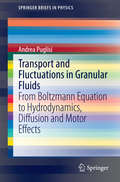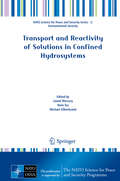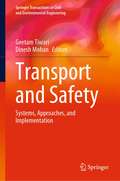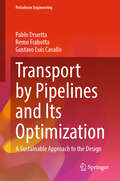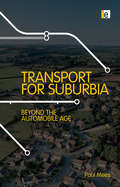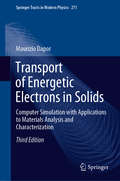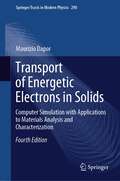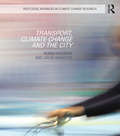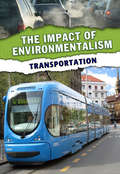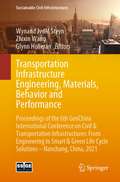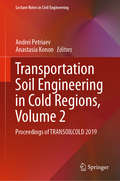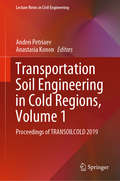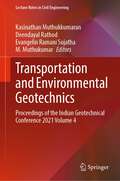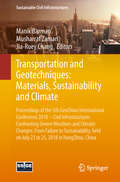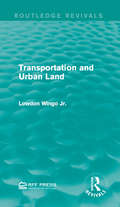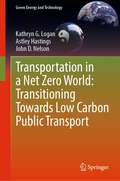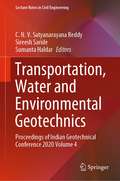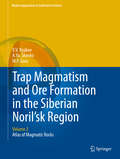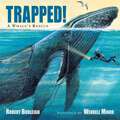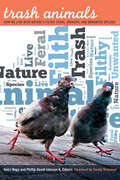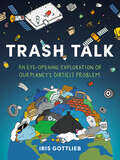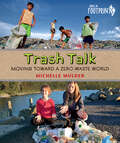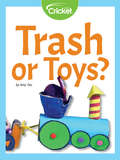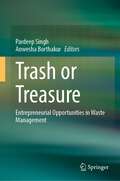- Table View
- List View
Transport and Fluctuations in Granular Fluids
by Andrea PuglisiThis brief offers a concise presentation of granular fluids from the point of view of non-equilibrium statistical physics. The emphasis is on fluctuations, which can be large in granular fluids due to the small system size (the number of grains is many orders of magnitude smaller than in molecular fluids). Firstly, readers will be introduced to the most intriguing experiments on fluidized granular fluids. Then granular fluid theory, which goes through increasing levels of coarse-graining and emerging collective phenomena, is described. Problems and questions are initially posed at the level of kinetic theory, which describes particle densities in full or reduced phase-space. Some answers become clear through hydrodynamics, which describes the evolution of slowly evolving fields. Granular fluctuating hydrodynamics, which builds a bridge to the most recent results in non-equilibrium statistical mechanics, is also introduced. Further and more interesting answers come when the dynamics of a massive intruder are discussed. Such non-equilibrium stochastic process offers a more precise and compact picture of the features foreseen at the more detailed levels of description. The dynamics of an intruder diffusing in a granular fluid reveal the clearest connection with recent theories on stochastic energetics and stochastic thermodynamics.
Transport and Reactivity of Solutions in Confined Hydrosystems
by Lionel Mercury Niels Tas Michael ZilberbrandThe present work reflects a multi-disciplinary effort to address the topic of confined hydrosystems developed with a cross-fertilization panel of physics, chemists, biologists, soil and earth scientists. Confined hydrosystems include all situations in natural settings wherein the extent of the liquid phase is limited so that the solid-liquid and/or liquid-air interfaces may be critical to the properties of the whole system. Primarily, this so-called "residual" solution is occluded in pores/channels in such a way that decreases its tendency to evaporation, and makes it long-lasting in arid (Earth deserts) and hyper-arid (Mars soils) areas. The associated physics is available from domains like capillarity, adsorption and wetting, and surface forces. However, many processes are still to understand due to the close relationship between local structure and matter properties, the subtle interplay between the host and the guest, the complex intermingling among static reactivity and migration pathway. Expert contributors from Israel, Russia, Europe and US discuss the behaviour of water and aqueous solutes at different scale, from the nanometric range of carbon nanotubes and nanofluidics to the regional scale of aquifers reactive flow in sedimentary basins. This scientific scope allowed the group of participants with very different background to tackle the confinement topic at different scales. The book is organized according to four sections that include: i) flow, from nano- to mega-scale; ii) ions, hydration and transport; iii) in-pores/channels cavitation; iv) crystallization under confinement. Most of contributions relates to experimental works at different resolution, interpreted through classic thermodynamics and intermolecular forces. Simulation techniques are used to explore the atomic scale of interfaces and the migration in the thinnest angstrom-wide channels.
Transport and Safety: Systems, Approaches, and Implementation (Springer Transactions in Civil and Environmental Engineering)
by Geetam Tiwari Dinesh MohanThis volume addresses a variety of issues on traffic safety policy, ranging from issues of climate change, urban equity, and transport safety, in a broad global and societal context, while retaining situation-specific details. Written by international experts on issues of transportation and traffic safety, it will be of special interest to advanced researchers in the engineering and planning disciplines working on these issues as well as policy makers concerned with setting up institutions and legislations for traffic safety.
Transport by Pipelines and Its Optimization: A Sustainable Approach to the Design (Petroleum Engineering)
by Pablo Druetta Remo Frabotta Gustavo Luis CavalloThis textbook introduces pipeline design, one of the most efficient techniques for mass and energy transport available today. The global economy heavily relies on pipelines. However, designing a pipeline is more complex than it might seem; it involves many technical and economic factors that must work together to create an optimized system. The book begins with basic concepts of pipelines, including a description of the materials used, heat transfer between the system and medium, and the main components of pumping and compression stations, which are vital for the subsequent chapters. It then presents a simple yet detailed overview of these factors and introduces a mathematical methodology that combines them to deliver an optimized pipe design, minimizing costs and reducing energy consumption. The book also covers the transient verification of this design using well-known balance equations and material property relationships for both incompressible and compressible fluids, to validate the initial design. Finally, the book explores the analysis of multiphase pipelines, where the goal is to transport a particular material (e.g., solid) using a different medium (e.g., air or water).
Transport for Suburbia: Beyond the Automobile Age
by Paul MeesThe need for effective public transport is greater than ever in the 21st century. With countries like China and India moving towards mass-automobility, we face the prospects of an environmental and urban health disaster unless alternatives are found. It is time to move beyond the automobile age. But while public transport has worked well in the dense cores of some big cities, the problem is that most residents of developed countries now live in dispersed suburbs and smaller cities and towns. These places usually have little or no public transport, and most transport commentators have given up on the task of changing this: it all seems too hard. This book argues that the secret of 'European-style' public transport lies in a generalizable model of network planning that has worked in places as diverse as rural Switzerland, the Brazilian city of Curitiba and the Canadian cities of Toronto and Vancouver. It shows how this model can be adapted to suburban, exurban and even rural areas to provide a genuine alternative to the car, and outlines the governance, funding and service planning policies that underpin the success of the world's best public transport systems.
Transport in the Atmosphere-Vegetation-Soil Continuum
by Arnold F. Moene Jos C. van DamTraditionally, soil science, atmospheric science, hydrology, plant science and agriculture have been studied largely as separate subjects. These systems are clearly interlinked, however, and in recent years a great deal of interdisciplinary research has been undertaken to better understand the interactions. This textbook was developed from a course that the authors have been teaching for many years on atmosphere-vegetation-soil interactions at one of the leading international research institutes in environmental science and agriculture. The book describes the atmosphere-vegetation-soil continuum from the perspective of several interrelated disciplines, integrated into one textbook. The text is interspersed with many student exercises and problems, with solutions included. It will be ideal for intermediate to advanced students in meteorology, hydrology, soil science, environmental sciences and biology who are studying the atmosphere-vegetation-soil continuum, as well as researchers and professionals interested in the observation and modelling of atmosphere-vegetation-soil interactions.
Transport of Energetic Electrons in Solids: Computer Simulation with Applications to Materials Analysis and Characterization (Springer Tracts in Modern Physics #271)
by Maurizio DaporThis book describes, as simply as possible, the mechanisms of scattering (both elastic and inelastic) of electrons with solid targets (electron–atom, electron–plasmon, and electron–phonon interactions). It also presents the main strategies of the Monte Carlo method, as well as numerous comparisons between simulation results and the experimental data available in the literature. Furthermore it provides readers with all the information they need in order to write their own Monte Carlo code and to compare the obtained results with the many numerical and experimental examples presented throughout the book. An extended and updated third edition of a work published in 2014 (first edition) and in 2017 (second edition) on the application of the Monte Carlo method to the transport of fast electrons in solids, this book includes, as novel topics, the theory of polarized electron beams (i.e. density matrix and spin polarization), the study of elastic scattering by molecules, a classical treatment of the Bethe-Bloch stopping power, a simple derivation of the f- and ps-sum rules, the Vicanek and Urbassek formula for the calculation of the backscattering coefficient, the Wolff theory describing the secondary electron spectra, and fundamental aspects of the interactions between electrons beams and solid targets. Further, it describes a completely analytical approach (the so-called multiple reflection method) for calculating the absorbed, backscattered, and transmitted fractions of electrons from unsupported and supported thin films. It also discusses recent applications of the Monte Carlo method.
Transport of Energetic Electrons in Solids: Computer Simulation with Applications to Materials Analysis and Characterization (Springer Tracts in Modern Physics #290)
by Maurizio DaporThis book describes the computational methods most frequently used to deal with the interaction of charged particles, notably electrons, with condensed matter. Both elastic and inelastic scattering phenomena are discussed, and methods for calculating the relevant cross sections are explained in a rigorous but simple way. It provides readers with all the information they need in order to write their own Monte Carlo code and to simulate the transport of fast particles in condensed matter. Many numerical and experimental examples are presented throughout the book.The updated and extended fourth edition features ab initio methods for calculating dielectric function and energy loss function. Non-relativistic partial wave expansion method for calculating the differential elastic scattering cross section is also included in this new edition. It represents a very useful introduction to the relativistic partial wave expansion method, i.e., to the Mott theory, already discussed in the previous editions of this book. Further details about the effects of spin-polarization on the differential elastic scattering cross section are included in this new edition. The multiple reflection method is extended to the general case of a system composed of a set of layers of different materials and thicknesses. Analytical expressions are provided for calculating the backscattering coefficient of multilayers. New results are presented, notably about Monte Carlo simulations of reflection electron energy loss spectra and of the radial dose deposited along the track of ions impinging on materials.
Transport, Climate Change and the City (Routledge Advances in Climate Change Research)
by David Banister Robin HickmanSustainable mobility has long been sought after in cities around the world, particularly in industrialised countries, but also increasingly in the emerging cities in Asia. Progress however appears difficult to make as the private car, still largely fuelled by petrol or diesel, remains the mainstream mode of use. Transport is the key sector where carbon dioxide (CO2) emissions seem difficult to reduce. Transport, Climate Change and the City seeks to develop achievable and low transport CO2 emission futures in a range of international case studies, including in London, Oxfordshire, Delhi, Jinan and Auckland. The aim is that the scenarios as developed, and the consideration of implementation and governance issues, can help us plan for and achieve attractive future travel behaviours at the city level. The alternative is to continue with only incremental progress against CO2 reduction targets, to ‘sleepwalk’ into climate change difficulties, oil scarcity, a poor quality of life, and to continue with the high traffic casualty figures. The topic is thus critical, with transport viewed as central to the achievement of the sustainable city and reduced CO2 emissions.
Transportation (The Impact of Environmentalism)
by Andrew SolwayWe are all aware of the importance of the environment - it's in the news, it affects our behavior and the decisions we make every day. But what actual impact has environmental thinking had on the world around us? This thought-provoking book looks at the way new ideas about the environment and sustainability have changed the way we travel, and will so do in the future.
Transportation Infrastructure Engineering, Materials, Behavior and Performance: Proceedings of the 6th GeoChina International Conference on Civil & Transportation Infrastructures: From Engineering to Smart & Green Life Cycle Solutions -- Nanchang, China, 2021 (Sustainable Civil Infrastructures)
by Wynand JvdM Steyn Zhixin Wang Glynn HolleranSociety needs to travel to engage in productive and effective commerce, social, educational and related activities. Efficient travel is founded on an operational transport infrastructure system that is well-designed, engineering, constructed and maintained. This volume shares some of the latest innovations and thoughts in the areas of pavement infrastructure materials, behavior and performance. Access to this volume should enable the reader to gain an understanding of such novel information that should support improvements in the provision of an effective road transportation system for the benefit of the greater society served by the road network. The content is based on the contributions to the 6th GeoChina International Conference on Civil & Transportation Infrastructures: From Engineering to Smart & Green Life Cycle Solutions -- Nanchang, China, 2021.
Transportation Soil Engineering in Cold Regions, Volume 2: Proceedings of TRANSOILCOLD 2019 (Lecture Notes in Civil Engineering #50)
by Andrei Petriaev Anastasia KononThis volume comprises select papers presented during TRANSOILCOLD 2019. It covers the challenges and problems faced by engineers, designers, contractors, and infrastructure owners during planning and building of transport infrastructure in Arctic and cold regions. The contents of this book will be of use to researchers and professional engineers alike.
Transportation Soil Engineering in Cold Regions, Volume 1: Proceedings of TRANSOILCOLD 2019 (Lecture Notes in Civil Engineering #49)
by Andrei Petriaev Anastasia KononThis volume comprises select papers presented during TRANSOILCOLD 2019. It covers the challenges and problems faced by engineers, designers, contractors, and infrastructure owners during planning and building of transport infrastructure in Arctic and cold regions. The contents of this book will be of use to researchers and professional engineers alike.
Transportation and Environmental Geotechnics: Proceedings of the Indian Geotechnical Conference 2021 Volume 4 (Lecture Notes in Civil Engineering #298)
by M. Muthukumar Kasinathan Muthukkumaran Deendayal Rathod Evangelin Ramani SujathaThis book comprises the select peer-reviewed proceedings of the Indian Geotechnical Conference (IGC) 2021. The contents focus on Geotechnics for Infrastructure Development and Innovative Applications. This book covers topics related application of natural and artificial geosynthetics in shallow foundation bearing capacity enhancement, highway & railway pavements, high speed rail and geo-environmental applications. Topics also covered related to simulation of geosynthetic encased stone column, application of geosynthetic for ground improvement, pore size distribution of compacted expansive soils, MICP, landfills, among others. This book is of interest to those in academia and industry.
Transportation and Geotechniques: Proceedings of the 5th GeoChina International Conference 2018 – Civil Infrastructures Confronting Severe Weathers and Climate Changes: From Failure to Sustainability, held on July 23 to 25, 2018 in HangZhou, China (Sustainable Civil Infrastructures)
by Manik Barman Musharraf Zaman Jia-Ruey ChangThis book deals with the attempts made by the scientists, researchers and practitioners to address different emerging issues in transportation and geotechnical engineering. Papers focus on the following: (i) polymer-based dust suppressant,(ii) cement concrete materials, (iii) pavement preservation techniques, (iv) frost front in a cold-region circular tunnel, (v) metro station in non-cemented soil, (vi) seismic-liquefaction, (vii) mechanical responses of asphalt pavement at bridge approach, (viii) warm mix asphalt, and (ix) behavior of pile foundation. This volume is useful for the researchers and practitioners who work in the area transportation and geotechincal engineering. Papers were selected from the 5th GeoChina International Conference 2018 – Civil Infrastructures Confronting Severe Weathers and Climate Changes: From Failure to Sustainability, held on July 23 to 25, 2018 in HangZhou, China.
Transportation and Urban Land (Routledge Revivals)
by Lowdon Wingo Jr.Urban land is a precious resource and originally published in 1961, Transportation and Urban Land aims to create an approach to analysing and projecting its uses with a particular focus on the household sector. By considering matters such as employment centres, organisation and technology of transportation and marginal valuation of residential space, Wingo develops a model to estimate how much land is required for residential land uses. This title will be of interest to students of Environmental Studies and professionals.
Transportation in a Net Zero World: Transitioning Towards Low Carbon Public Transport (Green Energy and Technology)
by John D. Nelson Astley Hastings Kathryn G. LoganThis book discusses the importance of transitioning from conventionally fuelled, electric and hydrogen personal vehicles towards low carbon electric and hydrogen public transport. It presents international comparisons and case studies of countries who have successfully and unsuccessfully implemented policies to reduce their emissions from land-based transport. It discusses and provides policy recommendations to meet a net zero transport world by exploring potential issues, including infrastructure changes and electricity generation mix which may prevent targets being met successfully. The book also demonstrates how the COVID-19 pandemic has influenced individual transport choices and what will need to be done to ensure travel remains sustainable going forward. Aligned with an active area of academic and civil discourse on the topic of sustainable transportation systems, Transportation in a Net Zero World will be of interest to researchers, policy makers, and graduate students alike, in the fields of environmental science and transport studies.
Transportation, Water and Environmental Geotechnics: Proceedings of Indian Geotechnical Conference 2020 Volume 4 (Lecture Notes in Civil Engineering #159)
by Sireesh Saride Sumanta Haldar C. N. V. Satyanarayana ReddyThis book comprises select proceedings of the Indian Geotechnical Conference 2020 (IGC2020) focusing on emerging opportunities and challenges in the field of transportation geotechnics, scour and erosion, offshore geotechnics, and environmental geotechnology. The contents will be useful to researchers, educators, practitioners and policy makers alike.
Trap Magmatism and Ore Formation in the Siberian Noril'sk Region
by V. V. Ryabov A. Ya. Shevko M. P. GoraThe basis of this investigation is the petrographic and geochemical understanding of principal igneous rock types of the Noril'sk region, in order to demonstrate that these data provide unique and self-evident solutions to the problems of petrogenesis and mineralization. The results of the investigations are presented in two volumes: the first includes mainly text and the second contains illustrations. In the first volume, the state of the main problems of the genesis of igneous rocks with reference to Traps and related ore deposits is discussed, as well as short petrological descriptions of igneous complexes in the region, the mineral and geochemical diversity of the rocks, and aspects of the differentiation of basaltic melts and mineralization are described. Taking into account the vast number of publications on the petrology of Traps of the Noril'sk region, primary attention in the monograph is given to earlier unknown phenomena, as well as other aspects that are of great importance for solving genetic problems. Some exotic geologic targets such as the Mikchandinsky differentiated cover, the magnetite lava flow of the Putorana Plateau, the magmatogenic breccia of Kharaelakh and others are described in detail. The second volume contains an atlas of Rock Indications of igneous rock-types; formally identified reference rocks from all igneous complexes of the region, as well as photographs of thin sections of typical rocks and analytical tables of rocks and minerals from the key sections of sedimentary units and intrusions. Each rock type has been geochemically and petrographically analysed thereby providing a formal identity, complete with a photograph of the thin section. Photomicrographs of the rocks in this book will be a useful aid in visualizing the diversity of rock types in the Traps; each photograph reflecting a unique combination of minerals.
Trapped! A Whale's Rescue: A Whale's Rescue (Live Oak Media Ereadalong Ser.)
by Robert BurleighIn the icy waters of the Pacific, a massive humpback whale unexpectedly finds herself tangled in a net abandoned by fishermen. When a rescue boat and a convoy of divers arrive to help the struggling humpback, a realistic and moving encounter bridges the human and aquatic worlds.
Trash Animals: How We Live with Nature’s Filthy, Feral, Invasive, and Unwanted Species
by Kelsi Nagy Phillip David Johnson IIWhy are some species admired or beloved while others are despised? An eagle or hawk circling overhead inspires awe while urban pigeons shuffling underfoot are kicked away in revulsion. Fly fishermen consider carp an unwelcome trash fish, even though the trout they hope to catch are often equally non-native. Wolves and coyotes are feared and hunted in numbers wildly disproportionate to the dangers they pose to humans and livestock. In Trash Animals, a diverse group of environmental writers explores the natural history of wildlife species deemed filthy, unwanted, invasive, or worthless, highlighting the vexed relationship humans have with such creatures. Each essay focuses on a so-called trash species—gulls, coyotes, carp, cockroaches, magpies, prairie dogs, and lubber grasshoppers, among others—examining the biology and behavior of each in contrast to the assumptions widely held about them. Identifying such animals as trash tells us nothing about problematic wildlife but rather reveals more about human expectations of, and frustrations with, the natural world. By establishing the unique place that maligned species occupy in the contemporary landscape and in our imagination, the contributors challenge us to look closely at these animals, to reimagine our ethics of engagement with such wildlife, and to question the violence with which we treat them. Perhaps our attitudes reveal more about humans than they do about the animals. Contributors: Bruce Barcott; Charles Bergman, Pacific Lutheran U; James E. Bishop, Young Harris College; Andrew D. Blechman; Michael P. Branch, U of Nevada, Reno; Lisa Couturier; Carolyn Kraus, U of Michigan–Dearborn; Jeffrey A. Lockwood, U of Wyoming; Kyhl Lyndgaard, Marlboro College; Charles Mitchell, Elmira College; Kathleen D. Moore, Oregon State U; Catherine Puckett; Bernard Quetchenbach, Montana State U, Billings; Christina Robertson, U of Nevada, Reno; Gavan P. L. Watson, U of Guelph, Ontario, Canada.
Trash Talk: An Eye-Opening Exploration of Our Planet's Dirtiest Problem
by Iris GottliebAn eye-opening, illustrated look at something we often take for granted—our trash, and the systems in place that make it disappear (or not)In a world of mass consumption and busy schedules, taking the time to understand our own trash habits can be daunting. In Trash Talk, the ever-curious and talented Iris Gottlieb pulls back the curtain on the intricacies of the global trash production system and its contribution to climate change. From the history of the mafia&’s rule of the New York sanitation system to orbital debris (space trash) to the myth of recycling, Gottlieb will help readers see trash in a whole new way. Complete with beautiful illustrations and several landfills&’ worth of research, Trash Talk shines a much-needed light on a system that has been broken for far too long, providing readers with surprising, disgusting, and insightful information to better understand how we affect garbage and how it affects us.
Trash Talk: Moving Toward a Zero-Waste World (Orca Footprints #6)
by Michelle MulderHumans have always generated garbage, whether it's a chewed-on bone or a broken cell phone. Our landfills are overflowing, but with some creative thinking, stuff we once threw away can become a collection of valuable resources just waiting to be harvested. Trash Talk digs deep into the history of garbage, from Minoan trash pits to the Great Pacific Garbage Patch, and uncovers some of the many innovative ways people all over the world are dealing with waste.
Trash or Toys?
by Amy TaoReusing your trash to make toys can be lots of fun–and decrease pollution and waste! Things we use around the house get old and we throw them away. What if you use them to make toys or gadgets that make life better? Experts think reusing things may be better than recycling! Learn how to make a piggy bank from a plastic can or a train with egg cartons. What things can you create by reusing?
Trash or Treasure: Entrepreneurial Opportunities in Waste Management
by Pardeep Singh Anwesha BorthakurIn this book, we have contributions from experts working on diverse aspects of waste management and waste entrepreneurship with an aim to contribute toward a holistic understanding of the existing and forthcoming waste handling challenges. Waste entrepreneurship refers to the practice of creating and operating businesses that aim to address the problem of waste management. It signifies businesses that are dedicated to finding innovative solutions for managing waste and plays a crucial role in building a sustainable future. Waste entrepreneurs identify waste as a valuable resource and use state-of-the-art tactics to reduce, reuse, recycle, and re-purpose it. By developing new technologies, services, and products that help reduce waste and recycle materials, they can create new economic opportunities while simultaneously reducing the environmental impact of waste. The primary audience of this book are researchers (from a wide range of disciplinary backgrounds) working in the field of waste management (especially E-waste, Plastics, Paper and Cardboard Waste, Organic Waste, and Construction and Demolition Waste) and environmental sustainability. This book also contains descriptions of various facets of waste entrepreneurship from different countries which will be helpful for different entrepreneurs looking for business opportunities in the waste management sector, NGOs, government agencies, international agencies, and new researchers working in the related fields. In particular, the book could provide start-up ideas to the enthusiastic readers.
